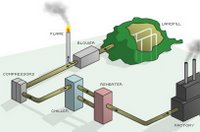Converting Landfills to Energy - Landfill Gas
 Extracting methane out of landfills is a laudable accomplishment, as far as it goes. After all, the methane secreted from landfills is 23 times more harmful a greenhouse gas than carbon dioxide. Any process that sequesters the methane and puts it to use as a replacement for fossil fuels (in this case, natural gas) is a win. Unfortunately, the process is not completely clean - one byproduct is the emission of carbon dioxide.
Extracting methane out of landfills is a laudable accomplishment, as far as it goes. After all, the methane secreted from landfills is 23 times more harmful a greenhouse gas than carbon dioxide. Any process that sequesters the methane and puts it to use as a replacement for fossil fuels (in this case, natural gas) is a win. Unfortunately, the process is not completely clean - one byproduct is the emission of carbon dioxide.
The global fossil fuel dependency crisis forces us to seek alternatives that are both energy efficient and economical. The most elegant solutions will be those that help solve one problem by solving another - converting liabilities into assets.
For instance, corn is not a liability, it is a valuable asset that is being exploited to provide an alternative source of energy.
Corn stover, on the other hand, is a liability - the more kernals we use for conversion to ethanol, the more corn plant waste we need to contend with. Converting corn stover to ethanol should, in this light, be seen to be a more elegant solution with a much higher EROIE (Energy Return On Invested Energy) than converting the corn kernals themselves.
It would make sense to co-site feedstock waste bioconversion facilities with every corn ethanol biorefinery in America. These emerging technologies will provide the necessary alchemy to accomplish this feat in an economical way - while dramatically expanding the volume of biomass feedstock available to convert.
This goal shouldn't be finding something constructive to do with landfills. The goal should be to convert the waste to energy BEFORE what's left over gets dumped into the landfill. It is estimated by the California Integrated Waste Management Board that the volume of unrecyclable waste could be reduced by 85% through the use of conversion technologies.
------------------------
Converting trash gas into energy gold
By Daniela Chen
CNN
According to the Environmental Protection Agency, every person in America produces an average of 4.5 pounds of garbage per day. Much of that trash goes into landfills, which are the largest human-related source of methane in the United States.
In 1994, the EPA formed the Landfill Methane Outreach Program (LMOP) under the United Nations Framework Convention on Climate Change. LMOP Team Leader Brian Guzzone said since methane is both a pollutant greenhouse gas and a source of energy, it offers a good opportunity to reduce greenhouse emissions and provide energy.
About 50 percent of all of the waste that we generate as a society today is put into municipal solid waste landfills, Guzzone said. The EPA encourages the capture of the resulting landfill gas and the energy produced from it.
The federal government has partnerships with more than 500 utilities, states, private businesses and communities. "The EPA's role is to work with communities that have landfills and help them realize the potential opportunity of their landfill," Guzzone said. That includes providing materials, technical services and community outreach.
Landfill Gas Interactive Tutorial
technorati greenhouse, methane, bioenergy, bioconversion, ethanol, emissions, global warming



2 comments:
This is very exciting. I wonder how difficult it would be to turn the gas into liquid methane fuel? I say this because I worry that since natural gas is so plentiful, that no one is going to implement this technology for something which has such little value.
We know that ethanol is only going to replace a portion of our liquid fuel needs, and methane could replace a bit more. Automobiles could be made to utilize gasoline, ethanol or methanol in any combination also. A GM engineer said that to do this would be only slightly more expensive than fitting them to run on ethanol. So, triple flex-fuelers could create demand for methanol, thereby spurring the growth of landfill extraction of methane liquid fuel.
I don't know what the cost is to convert methane into methanol. There is no reason not to embrace methanol in flex-fuel design unless there is a particular problem with emissions - VOCs for instance.
Post a Comment